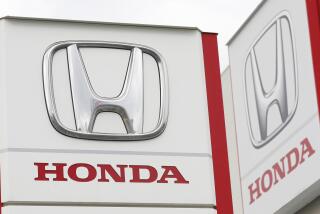‘May Wish to Inspect’ 747s: Boeing
- Share via
Amid growing concern that the crash of a Japan Air Lines 747 earlier this week might have been caused by a structural failure, Boeing Co. has issued a “service advisory” to all Boeing 747 operators, saying they “may wish to inspect” tail sections of the planes, company spokesmen said Friday.
The special inspection follows by one day a mandatory order, issued by Japan’s Transportation Ministry to the nation’s four airlines, calling for detailed inspections of Boeing 747 tail sections.
So far, the U.S. Federal Aviation Administration has not directed U.S. operators to take similar precautions. FAA spokesman Ed Pinto indicated Friday that the agency does not see a problem in the 747, based on current information. “If we found there is a potential for a problem, we would move very quickly,” Pinto said.
FAA Administrator Donald Engen established a 14-member working group to monitor the Japanese crash investigation, FAA spokesman Fred Ferar said.
FAA officials in Seattle, who oversee Boeing aircraft production, said they do not know whether the agency plans to require U.S. air carriers to make the same kind of inspections that JAL and the other Japanese airlines are conducting. Leroy Keith, engineering division manager at the FAA district office in Seattle, declined to discuss the JAL crash.
Major domestic operators of the 747 said Friday that they intend to conduct the tail inspections outlined by the Boeing advisory.
“We had already starting doing that before the bulletin came out,” said Pan American World Airways spokesman Mike Clark. “We started several days ago when the inquiries started focusing on the tail. We determined that we were going to go through our fleet and take a look at it.”
Northwest Orient Airlines, Trans World Airlines and United Airlines, all major operators of 747 aircraft, were reportedly preparing to conduct the tail cone inspections as well.
Meanwhile, Boeing officials insisted that Boeing’s service advisory does not indicate that it has concluded that the 747 may be subject to structural failures. The service advisory “does not advise or even suggest” that operators undertake the additional inspections, Boeing spokesman Richard Schleh said.
Boeing sent the advisory late Thursday in a telex message to airlines flying the 747, saying: “Until the cause of the accident is determined, operators may wish to inspect the vertical fin and rudder structure due to the reported decompression (of the JAL plane’s cabin). Operators may also wish to visually inspect the external and aft portions of the pressure shell structure.”
The pressure shell structure, also known as the “rear pressure bulkhead,” has become a focal point of the JAL accident investigation.
Japanese accident investigators said they have found the bulkhead, resembling the head of an umbrella, shattered and “peeled like an orange” amid the wreckage. The bulkhead is located at the end of the fuselage and is designed to hold in cabin pressure.
A failure of the pressure bulkhead would have caused cabin pressure to rush into the vertical tail assembly, which is not designed to withstand such internal pressures, and cause the tail assembly to burst.
That accident scenario would account for the nearly two dozen tail assembly parts that were found floating in Sagami Bay, more than 100 miles from the crash site.
Norman Birch, a private accident investigator in Los Angeles, said the Boeing 747 pressure bulkhead is subject to several dozen tons of pressure when the aircraft is at 20,000 feet, the reported altitude at which the JAL aircraft began reporting difficulty.
Boeing spokesman Schleh said, “Investigators at the scene have found the bulkhead and the part shows no evidence of fatigue or corrosion.”
More to Read
Inside the business of entertainment
The Wide Shot brings you news, analysis and insights on everything from streaming wars to production — and what it all means for the future.
You may occasionally receive promotional content from the Los Angeles Times.










